
Porto, Portugal

Contents: 9.1- Extension 9.1.1- Timing of Extension 9.1.2- Cryptic Thick-Skinned Extension 9.2- Welding 9.3- Extension plus Welding 9.4- Distinguishing between Extension, Welding and Extension Plus Welding 9.5- Rising and Reduction of a Diapir
The sketch below (fig. 225) depicts the main characteristics of a regional extension (halokinesis excluded):
(i) Extension is the consequence of an extensional tectonic regime, that is to say, a tectonic regime characterized by an ellipsoid of the effective stresses with a
1 vertical.
(ii) The only way to extend, or lengthen sediments, is by normal faulting.
(iii) Normal faults will strike parallel to
2. They are parallel to the intermediate effective stress (
2) of the ellipsoid.
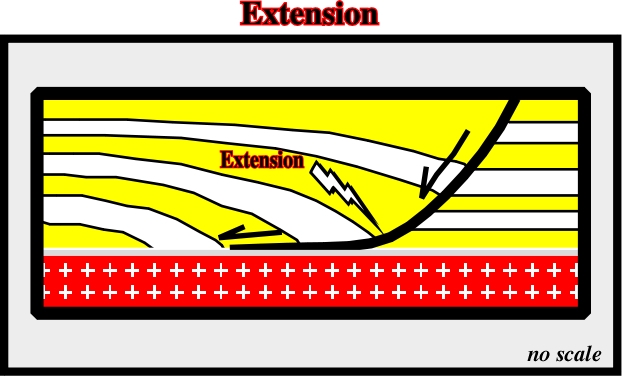
(iv) The hade of the normal-faults decreases with depth. Faults with such geometry are often erroneously called listric normal-faults (etymologically, the term listric fault was used to describe a fault not only with a curvilinear cartography but also with normal fault geometry, in the upper part, and reverse fault geometry, in the lower part. Such geometry is typical of the faults created by gliding when the pore pressure becomes big enough). The term listric (from the Greek listron) means shovel.
(v) The extension takes place only in the downthrown fault block.
(vi) There is no extension or thickening of the sedimentary interval within the up-thrown block, as illustrated in fig. 226 and 227.
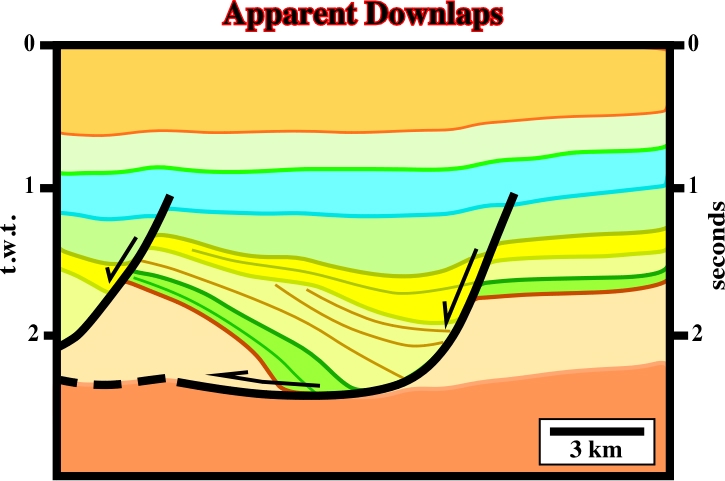
Fig. 226- On this line from the Ikpikpuk Umiat basin, extension is obvious. The basin had undergone a synsedimentary extensional tectonic regime above a décollement surface. The tectonic regime being characterized by
1 vertical and
2 striking N-S, the seismic line is a dip line. The normal-fault, limiting the extended area, is curvilinear and flat on the décollement surface. The sediments in the up-thrown block are undeformed as in the geological model illustrated in fig. 225.
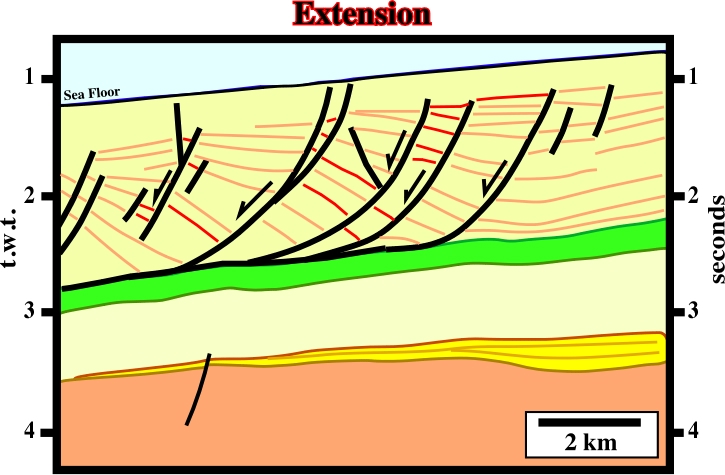
One of the most important hydrocarbon parameters is the age of trapping. Very often, and particularly when the trapping is morphological by juxtaposition (as said previously, this kind of trapping is often erroneously called « fault trap »), dry wells can be explain by trap timing: “traps must exist when hydrocarbon migration takes places”. In basins with evaporitic layers, often, extension produces salt flow that can induce explorationists to inaccurately date the extension time. In petroleum exploration, the parameter “migration time versus trapping” is utterly important, as illustrated below in Southern North Sea.
Southern North Sea
Following the Magoon’s terminology, in Southern North Sea, the more likely petroleum systems is known and it can be abbreviated as: “Paleozoic / Paleozoic ”. The generating petroleum subsystem is Paleozoic and the potential reservoirs are the Lower and Middle Permian sandstones (Rothliegende formation), which underlie the Zechstein (Upper Permian salt). In addition, knowing that the more likely hydrocarbon migration time, in this basin, is Upper Cretaceous, explorationists must put in evidence pre-Cretaceous traps to have a change to discover HC accumulations. Therefore, on the seismic lines (fig. 228), the key hydrocarbon parameter is to determine the age of the normal-faults. The potential traps are morphological by juxtaposition associated with fault displacement.
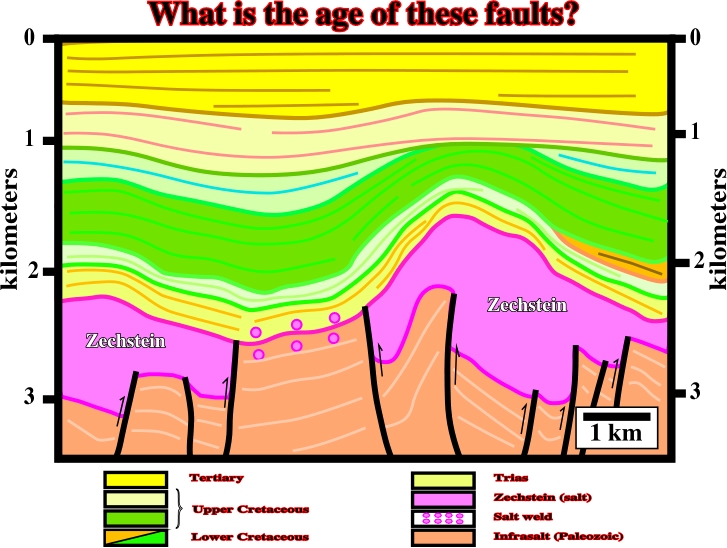
Fig. 228- To answer this crucial question, explorationists must decide what is the more likely way to create accommodation (space available to sedimentation) knowing that two main hypotheses can be invoked: (A) Extension before or during salt deposition or (B) Extension after salt deposition. Using the observed data, an explorationist must falsify both hypotheses and choose the more difficult to refute. However, to test them, they must know them (“Theory precedes Observation, K. Popper, 1934).
Hypothesis A & Hypothesis B
The hypothesis A, in which extension occurs before or during salt deposition, is depicted in fig. 229.
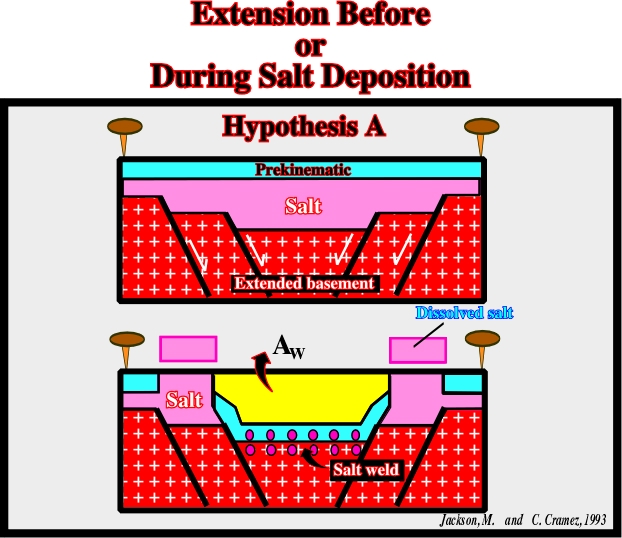
The hypothesis B, in which extension takes place after the deposition of the salt, is depicted in fig. 230.
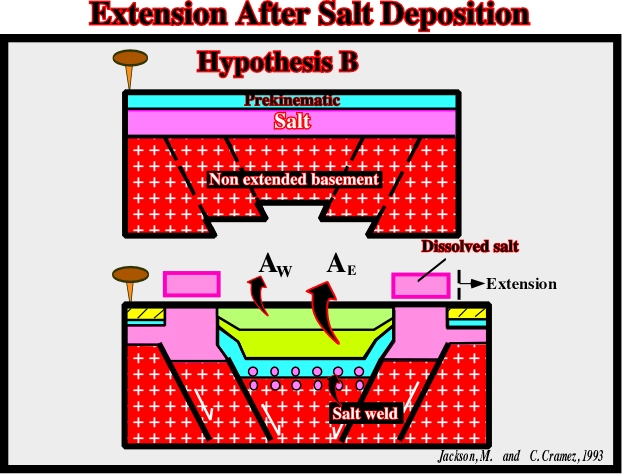
The hypothesis B can be summarized as follows:
- There is no extension before the salt deposition.
- The salt was deposited in a more or less horizontal and continuous stratigraphic layer.
- Overlying the salt, isopachous sedimentary intervals were deposited (prekinematic layers).
- A regional extension took place and reactivated, as normal faults, the pre-existent faults or fracture zones of the infra-salt strata.
- The salt flowed laterally and downward filling the space created by lengthening.
- Such a salt flowage induced in the overburden (above the prekinematic layers) a depocenter as well as a tectonic disharmony and a salt weld.
- A regional compressional tectonic regime took place and thereof the cover was shortened.
- The compression could locally reactivate the salt layer initiating a halokinetic phase.
Summing up:
(i) The faults postdate the salt deposition.
(ii) The faults postdate the prekinematic layer.
(iii) The associated morphological by juxtaposition traps postdate the hydrocarbon migration.
The hydrocarbon exploration implications of these hypotheses are contradictory. Centrifuge models were performed in order to test if the distinguished characteristics could be applied on seismic data (fig. 231 and fig. 234).
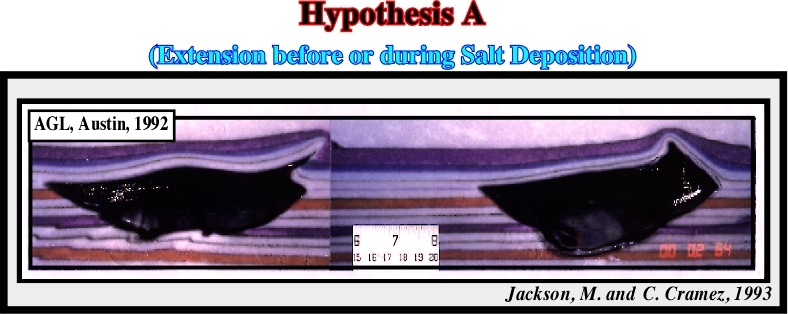

The centrifuge model of hypothesis A suggests that the final result does not fit the geometry observed on the seismic lines (fig. 228). Indeed,
- On the model, the faults show a reverse geometry. However, such geometry is not observed on the seismic line (fig. 228), in which:
(i) In spite of the fact that they keep their original normal geometry, the faults are reverse.
(ii) The reactivation, during the compressional tectonic regime, was not enough to change their geometry completely.
(iii) The null point is too high on the fault plane.
- On the model, the majority of the faults dip toward the same direction, what is not the case on the seismic line.
- On the model, there is a thrust-fault with the salt in the up-thrown block. There is no thrusting on the line (fig. 228).
- On the seismic line, the inverted grabens are filled by salt, which is not the case on the model.
- On the model, the sedimentary layers are isopachous. They are prekinematic. On the seismic line, there is a sharp thickness variation allowing the division of the overburden into prekinematic, synkinematic and postkinematic
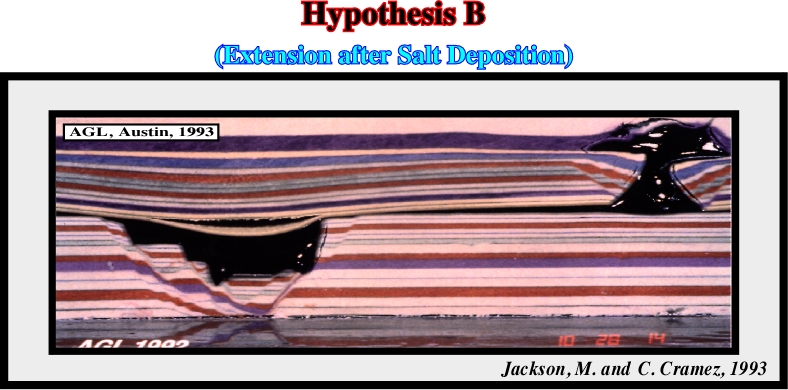
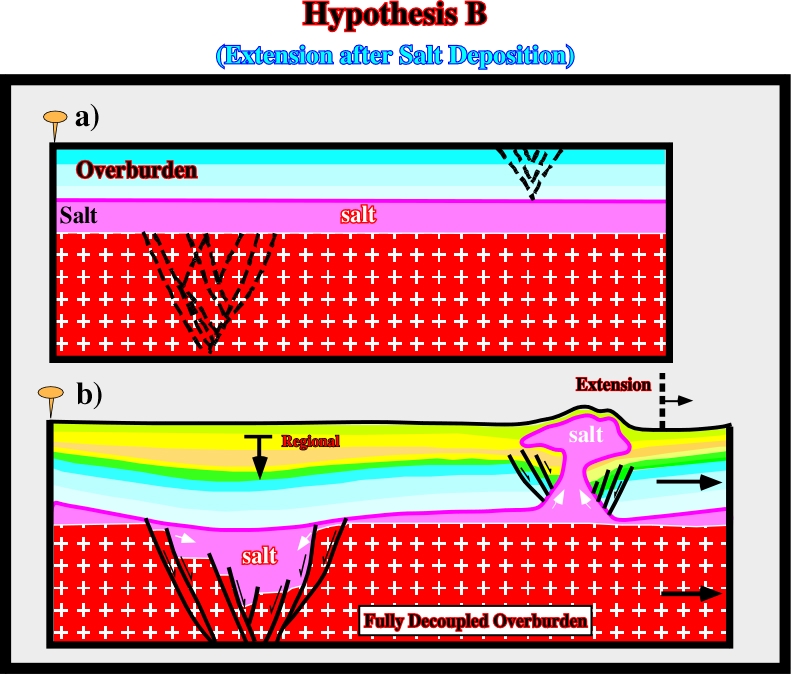
In conclusion: The model B seems to corroborate the hypothesis of a post-salt extension, which tell us that the faults on the seismic line are posterior to the salt deposition and subsequently the associated traps are probably posterior to the migration of the generated hydrocarbons.
Restoration Test
Similarly, the seismic line illustrated in fig. 235 poses the same problem to the explorationist. What is the age of the faults? What is the age of the sub-salt traps? These questions are paramount. In the area, the hydrocarbon migration of the main petroleum system is largely post-salt.
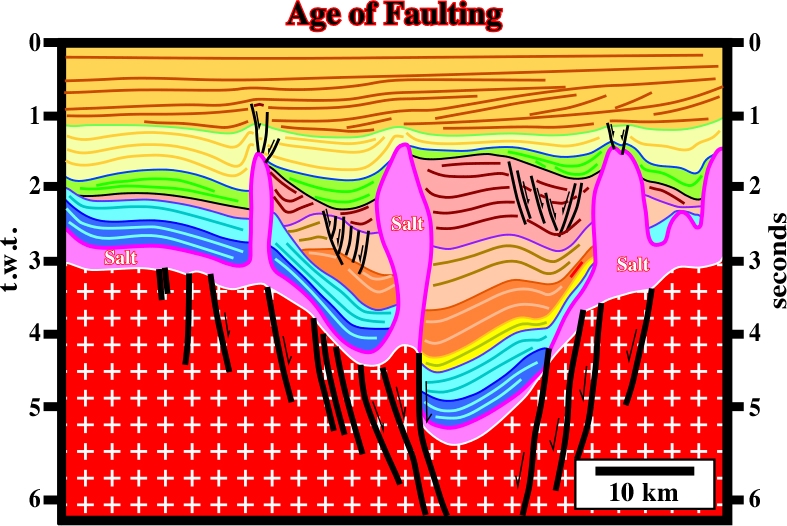
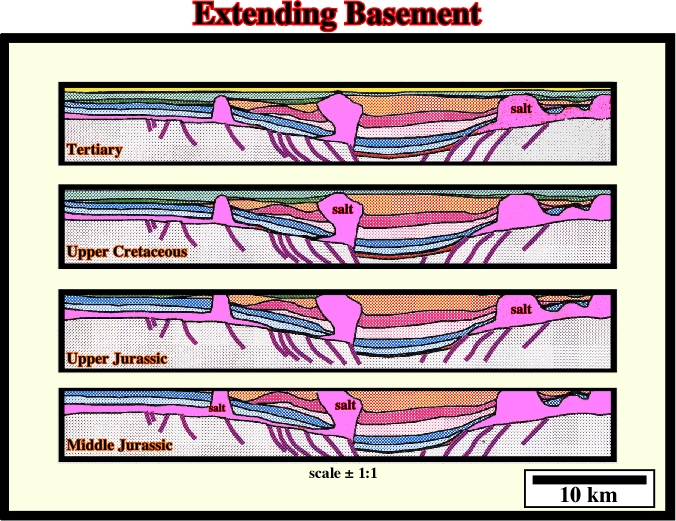
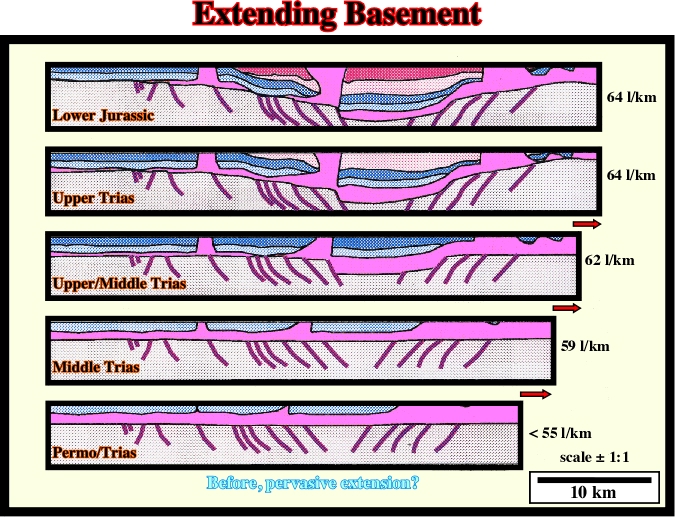
Several years ago, Sheeval and Dale (1989) proposed a thick-skinned extension in offshore Cabinda (Angola enclave). The geological sketch shown in fig. 238 illustrated this type of extension.
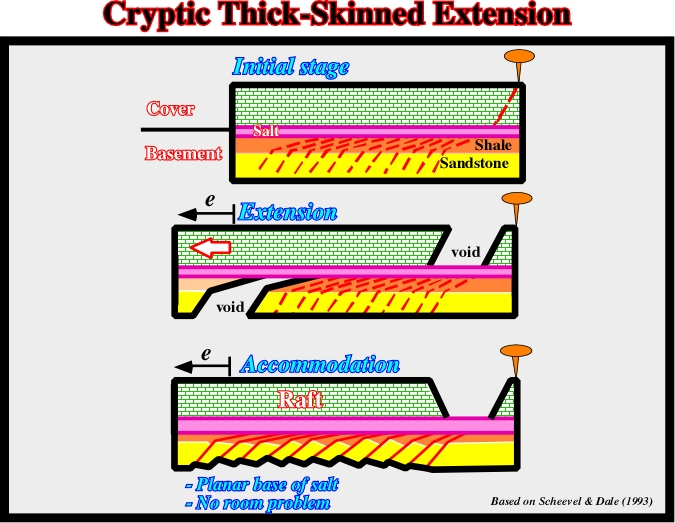
The cryptic thick-skinned can be summarized as follows (fig. 239):
a) In an initial stage, three stratigraphic intervals are deposited more or less horizontally:
- Infra-salt strata, composed by shales and sandstones
- A salt layer- A prekinematic calcareous overburden.
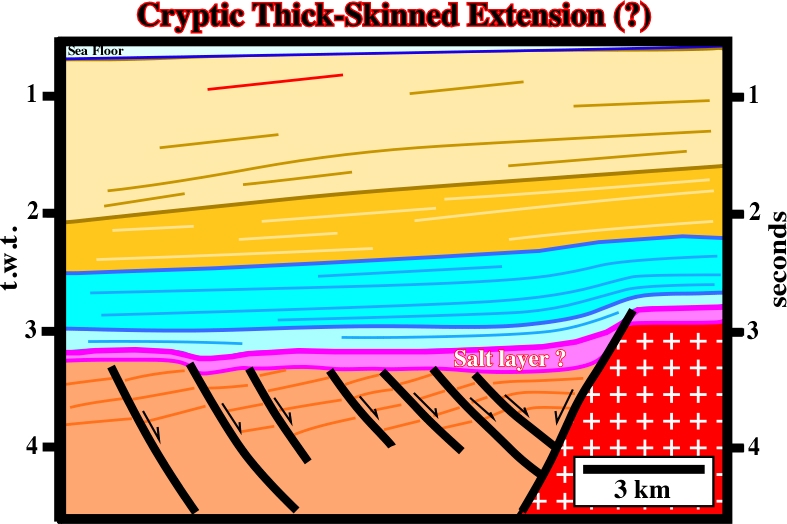
b) In a second stage, all deposited stratigraphic intervals are lengthened by regional extensional tectonic regime:
- A normal fault propagates from the basement to the overburden through the salt layer.
- Two virtual potential voids are created; One within the overburden and the other on the sub-salt strata.
c) In a last phase (accommodation phase):
- Synkinematic sediments fill the potential void within the overburden and sub-salt sediments fill the potential void within the infrastructure. The sub-salt strata are extended by normal-faults in order to solve a space problem (E nihilo nihil, in nihilum nil pose reverti).
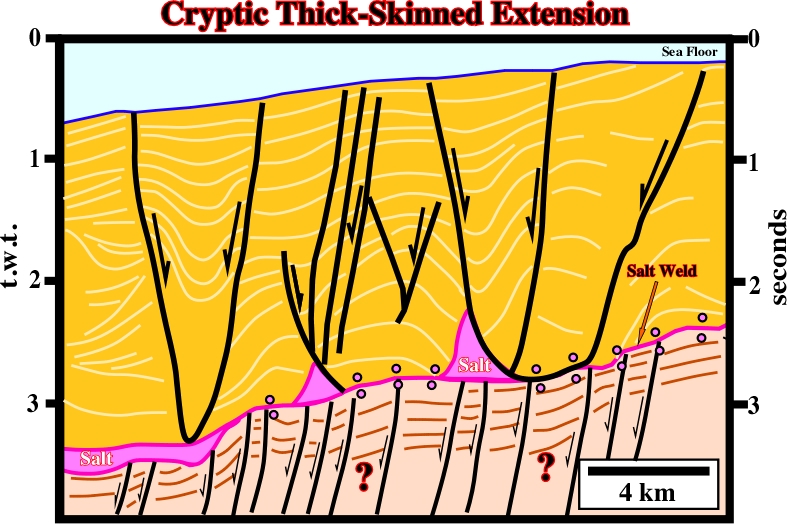
The figure below (fig. 241) illustrates a total salt reduction and the subsequent formation of a salt weld without regional extension.
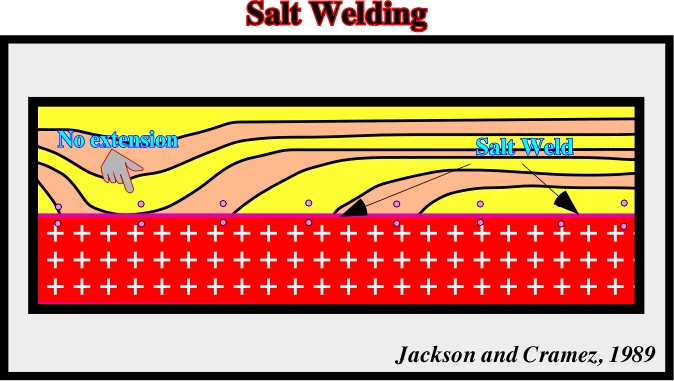
In fig. 241, the depocenter indicated by “no extension”, was created by total salt removal either of a salt roller or a small diapir. It is interesting to notice that in such an extreme case, the surface associated with the top of the salt (surface defined by reflection terminations) disappeared; it becomes coincident with the salt welding. The geometry of the chronostratigraphic lines can be interpreted as progradational package, that is to say the geometrical relationships are not downlap, since the thickness between the two consecutive time lines increases progressively toward the discontinuity (fig 242). A real downlap relationship implies a seaward thinning since the interval becomes condensed down-dip (fig. 243).

Fig. 242- Salt flowage creates (i) a compensatory subsidence, (ii) a salt welding and (iii) an apparent downlap surface induced by a down and basinward gliding of the synkinematic layer onlap relationships.
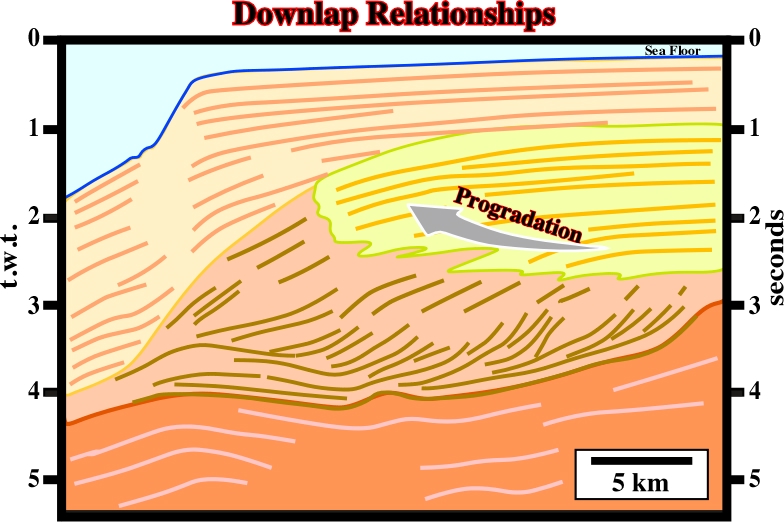
Fig. 243- Real downlap geometrical relationships between seismic markers are associated with progradational, or forestepping intervals, which seaward become condensed stratigraphic interval. They have a convergent down to basin geometry.
In the following geological sketch (fig. 244), the geometrical relationships suggest not only regional extension but salt welding as well. In the downthrown block, there is extension and welding, while in the up-thrown block only welding takes place.
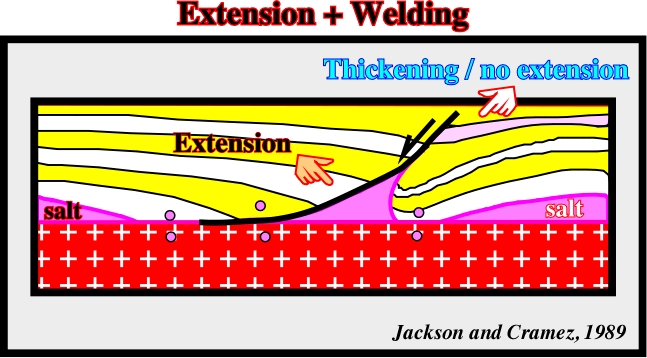
Fig. 244- On this sketch are summarized all characteristic geometrical relationships between the chronostratigraphic lines of a stratigraphic column that had undergone extension and salt welding.
On the other hand, it must be notice that in both faulted blocks of the sketch above, the stratigraphic intervals thicken toward the fault. On the up-thrown block, the thickening is just due to the withdrawal of the salt. Thereof no major regional extension is associated.
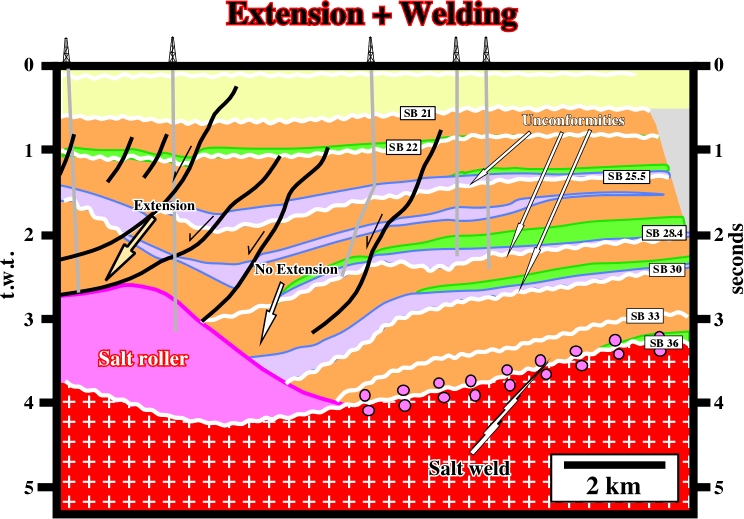
Fig. 245- The extension occurs in the downthrown block of the main fault, while welding occurs in the up-thrown faulted block. On this line, the depocenter is induced by the salt flowage, which creates a big salt roller, which should not be confused with a salt diapir
When extension and welding are combined (fig. 243), the continuation of the salt flowage breaks the salt continuity creating:
a) Two salt welds (one is a fault weld) and b) A salt roller on the up-thrown faulted block.
9.4- Distinguish Extension from Welding
The major differences between (i) extension, (ii) extension plus welding and (iii) welding are depicted on the three next geological sketches (figs. 246 to 248).

Fig. 246- In a pure extension over a thin salt layer, or along a décollement surface, apparent downlaps are developed against the tectonic disharmony (take a look at the window).

Fig. 247- Apparent downlap relationships are also developed when extension and welding take place. The window shows the same geometry as in previous figure.
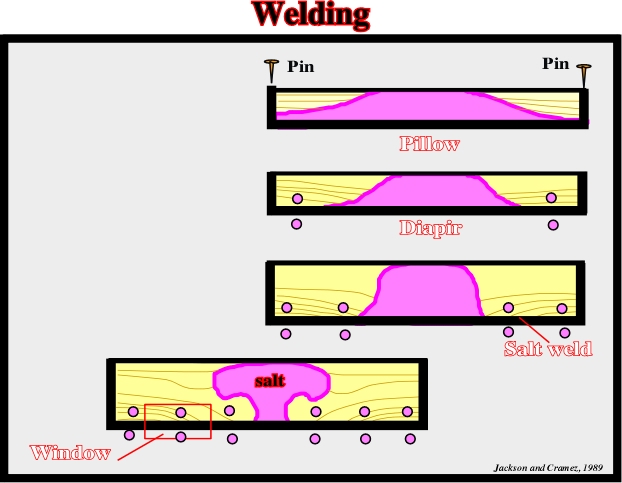
Fig. 248- In pure welding (halokinesis), apparent downlaps are also developed in association with the salt weld. Outside of the geological context, it is impossible to differentiate apparent downlap geometrical relationships induced by extension, from those created either by extension plus welding or just by welding. Explorationists cannot work in isolation and cannot progress from the particular to the general.
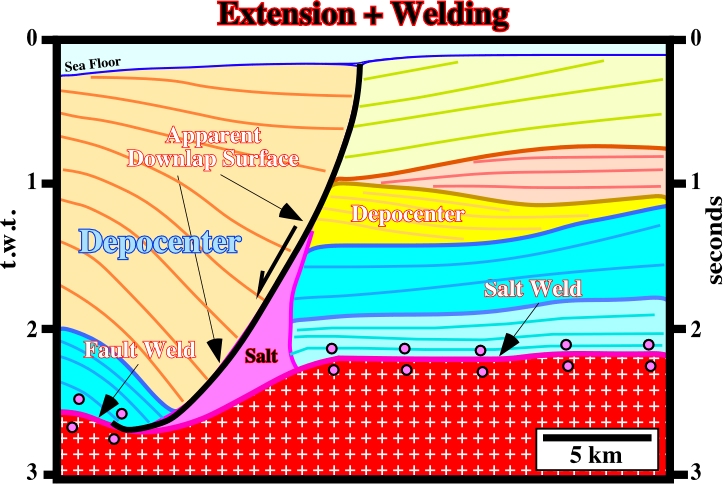
Fig. 249- On this line of the offshore Angola, which regional geological setting is well known, the geometrical relationships between the seismic marker define seismic surfaces suggesting a regional extension. An extensional tectonic regime and salt welding, mainly induced by halokinesis, exist in thee area. A salt weld (halokinesis) is recognized in the up-thrown faulted block. A fault weld (salt tectonics) is recognized in the down-thrown block. Also, (i) an apparent downlap surface and depocenter thickening toward the fault plane is recognized in the down-thrown faulted block (extension + welding) and (ii) a depocenter, induced by shrinkage of the salt roller, thickening westward is recognized in the up-thrown block (halokinesis).
9.5- Rise and Reduction of a Diapir
To end this chapter, in the next figure (fig. 250), is illustrated the rising and reduction of a salt diapir. Notice that:
- There is an initial slope on the top of the salt layer.
- Since the diapir rises, depocenters are formed as well as salt welds and rafts (see next chapter).
- The extension is underline by the fault heaves.
- When salt reduction starts, the central depocenter is initiated.
- Continuation of salt reduction creates relict diapir, a primary salt weld and a décollement fault.
- Chronostratigraphic lines and reflection terminations can be tilted.
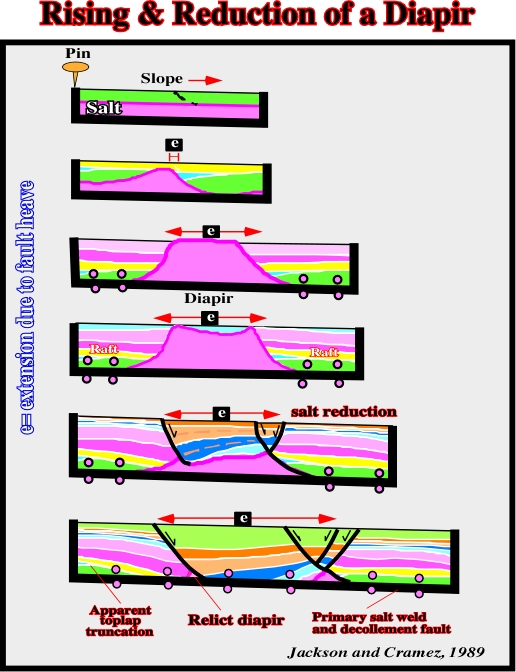
Fig. 250- In this geological evolution, one can see that by compensatory subsidence a depocenter is developed in the overburden at the place of the diapir. In the same way, as the salt flows away, generally down-dip, salt welds and rafts (see next chapter) are developed, as well as a relict diapir. Very often, salt reduction is incomplete. The last stage (a continuous salt weld) is not reached. The evolution can stop when a depocenter is developed on the top of the diapir. In certain basins, or in particular areas, characterized by local compressional regimes tectonic, inversions are possible. Shortened depocenters can be recognized on the top of diapirs (see fig. 251 and 252).

Fig. 251- In spite of the fact that in this seismic line, from Southern North Sea, the vertical and horizontal scales are approximate, it is quite evident that the depocenter overlying the salt diapir was induced by a reduction of the salt structure. Indeed, the depocenter thickens inward, that is to say, toward the centre of the diapir. Later a slight compression shortened the depocenter creating a subtle inversion in the central part. Even more evident inversions of these depocenter are known in offshore Angola as illustrated in next figure.

Fig. 252- The tectonic inversions of the depocenters in the overburden associated with diapir reductions are well know in offshore Angola. Actually, when on a seismic line, a depocenter, that is to say, a convergent thickening interval, overlying a salt diapir, is in a high structural position, interpreters must hypothesize a tectonic inversion induced by a local, or regional, compressional tectonic regime. These tectonic inversions can be associated with regional shortening or local reactivation of the old pre-existent fault or fracture (see fig. 253).
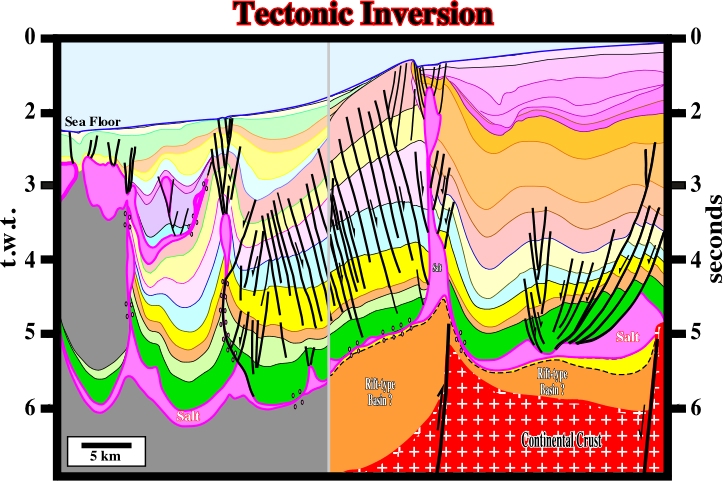
Fig. 253- A reactivation of the pre-existent normal fault bordering a rift-type basin, in late Tertiary, created a tectonic inversion easy recognised on the bathymetry. A probable tectonic evolution of this structures illustrated on this line is proposed in fig. 254.

Fig. 254- In this tectonic evolution, it is hypothesized that the Late Tertiary shortening of the overburden it is induce by the reactivation, in reverse fault, of a pre-existent normal faulting bordering a rift-type basin, which is easily recognized in the sub-salt strata. Due to the reactivation, locally, the lower structural points become high and the high structural points become lower points.
to continue press
next